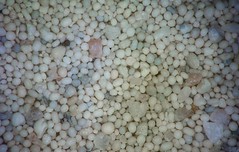Not much to write this morning. I've got to put some lecture content together for soil moisture potentials. For now, check out some ooid sand collected from the shores of the Great Salt Lake. So my question to you is: what process forms these little spheres? I could just tell you, but that wouldn't be as interactive as I'd like.


Because ooids are formed by being rolled around on the sea-bed, they are rounded in shape. The shape of the nuclei also influences this: The spherical ooids have a spherical nucleus, and the elongated, ovoid ooids have elongated nucleus, e.g. shell fragments or an elongated calcite grain. In the case of a compound ooid, the fact that there are two (or more) nuclei results in a wide variety of rounded/ovoid ooid shapes, depending upon the size, shape, composition and position of the nuclei, for example the elongated shape of the ooids around the long calcite crystals.
ReplyDeleteOoids are formed by direct precipitation of carbonate from shallow marine waters, where small particles (which become the nuclei) are continually rolled around on the sea bed by wave- or tide-generated currents, which move the water. The concentric layers of CaCO3 visible in a thin section are evidence of the precipitation and build up of CaCO3 around the nuclei during this process, which results in the spherical appearance of the grains.
ReplyDeleteI'd love to know the locality (more specific) where these were collected - I really want some for my teaching collection!
ReplyDeleteAdditional information, some ooids form as excretion from coral eating varieties of fish (eg parrot fish). This type is referred to as peloids or peloidal. Environments conducive to ooid production today are the Bahamas and Persian gulf. The Bahamas are particularly productive due to cold carbonate-supersaturated waters upwelling along the ramp and meeting warm tropical seas to enhance precipitation of aragonite.
ReplyDelete